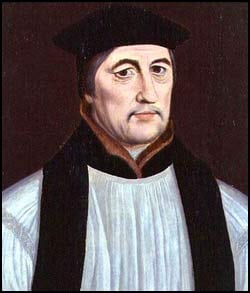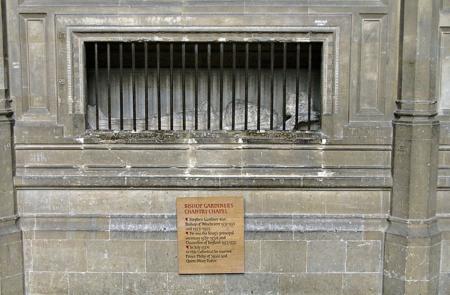 On this day in history, 12th November 1555, Stephen Gardiner, Bishop of Winchester and Mary I’s Lord Chancellor, died. He was buried at his seat of Winchester Cathedral where his tomb can still be seen today in the Bishop Gardiner Chantry Chapel.
On this day in history, 12th November 1555, Stephen Gardiner, Bishop of Winchester and Mary I’s Lord Chancellor, died. He was buried at his seat of Winchester Cathedral where his tomb can still be seen today in the Bishop Gardiner Chantry Chapel.
Stephen Gardiner’s date of birth is not known, with some saying 1483 and others saying 1493 or 1497, but he was born in Bury St Edmunds in Suffolk. His father was William Gardiner (some say John Gardiner), a cloth merchant and a mercenary hired during the War of the Roses. According to Welsh accounts of the 1485 Battle of Bosworth, it was “Wyllyam Gardynyr” who killed King Richard III with a poleaxe. Sir William Gardiner later married Helen Tudor, a woman said to have been the illegitimate daughter of Jasper Tudor, uncle of King Henry VII.
As a young man, Gardiner met the famous Humanist and scholar, Desiderius Erasmus, in Paris and he studied at Trinity Hall, Cambridge. He received the degree of doctor of civil law in 1520 and of canon law in 1521 and went on to work for Cardinal Thomas Wolsey as secretary, meeting Henry VIII for the first time in 1525 at The More in Hertfordshire for the signing of the Treaty of the More between the King and Francis I of France. Two years later, in 1527, Gardiner and Sir Thomas More worked as commissioners in arranging, with the French ambassadors, a treaty to obtain support for an army against the Holy Roman Emperor, Charles V, in Italy.
In 1527, Gardiner accompanied his master, Wolsey, on a diplomatic mission to France to gain the French King’s support for the King’s Great Matter or “secret matter”, his wish to divorce Catherine of Aragon. A year later, Gardiner was sent to Italy with Edward Foxe, the provost of King’s College, Cambridge, to secure a decretal commission from the Pope which would allow Cardinal Wolsey to rule on the validity of the King’s marriage without appeal to Rome. Although Gardiner was an expert on canon law, and so was at a great advantage, Pope Clement VII had recently been imprisoned by Charles V’s troops and was wary of offending the Emperor who was Catherine of Aragon’s nephew and so refused to grant the decretal commission and, instead, granted a general commission to allow Cardinal Wolsey to try the case in England with the Papal Legate, Cardinal Campeggio. You can read more about the Legatine Court in Cardinal Campeggio and the Legatine Court.
In 1526 Gardiner was appointed Archdeacon of Taunton and then in 1529 Archdeacon of Norfolk, a post which he resigned from in 1531 when he became Archdeacon of Leicester. In November 1531 he was appointed Bishop of Winchester after successfully procuring a decision from the University of Cambridge on the unlawfulness of a man marrying his dead brother’s wife. However, he did offend the King a year later when he was involved in preparing the Answer of the Ordinaries, a reply to the Supplication Against the Ordinaries.
In May 1533, Gardiner assisted the Archbishop of Canterbury, Thomas Cranmer, in pronouncing the marriage between Henry VIII and Catherine of Aragon null and void and in 1535 he was one of the bishop asked to vindicate Henry VIII’s new title “Supreme Head of the Church of England, something which he did by writing his treatise “De vera obedientia”, in which he argued that rulers were entitled to supremacy in their own country’s churches and that the pope had no legitimate power over other churches.
Between 1535 and 1539, Gardiner was mostly abroad on diplomatic missions, but in 1539 he helped to prepare The Six Articles which reaffirmed the traditional Catholic doctrine on transubstantiation, clerical celibacy, the vow of chastity, the withholding of the cup from the laity at communion, private masses and auricular confession. In 1543, Gardiner was involved in the Prebendaries’ Plot against Cranmer, along with his nephew, Germain Gardiner. The plot failed when the King supported Cranmer but Gardiner survived, although his nephew, the scapegoat, was executed for treason. In 1546, Gardiner,a long with Lord Chancellor Wriothesley, attempted to turn the King against his sixth wife, the Reformist Catherine Parr. The plot failed when Catherine managed to reconcile with the King.
On the 28th January 1547, King Henry VIII died and although Gardiner had been one of his trusted advisers he was not named as an executor in the King’s will. During the Protestant reign of Edward VI, Gardiner was imprisoned, first in Fleet and then in the Tower of London, for his opposition to the religious changes being made. However, he was released at the accession of Mary I in 15553, restored to his bishopric and made the Queen’s Lord Chancellor. He crowned Mary I Queen of England at her coronation at Westminster Abbey on the 1st October 1553 and helped Mary to restore Catholicism and, ironically, overturn the annulment of her parents’ marriage, making her legitimate. He was also instrumental in the marriage negotiations between Mary and Philip II of Spain and married the couple at Winchester Cathedral on the 25th July 1554.
It is not clear what Gardiner’s role was in the Marian persecutions, but it appears that he preferred to try and persuade people to save themselves by recanting and reconciling themselves to the church. It has been pointed out that in his own diocese nobody was persecuted until after Gardiner’s death.

In May 1555, Gardiner carried out his last diplomatic mission to France, to promote peace, a mission that was not successful, and in October 1555 he opened Parliament. On the 12th November 1555, after being taken ill at the end of October, the famous Tudor statesman and lawyer, Stephen Gardiner, Bishop of Winchester and Lord Chancellor of England, died. It is thought that he was in his sixties and that he had been suffering from jaundice and dropsy. It is said that as he lay dying the story of the Passion was read to him and that his dying words, after hearing of the denial of Peter, were “Erravi cum Petro, sed non flevi cum Petro”, “Like Peter I have erred, unlike Peter I have not wept”, an allusion to his weakness during the reign of Henry VIII.
Notes and Sources
- Stephen Gardiner Wikipedia page
- Article on Stephen Gardiner, at The Original Catholic Encyclopedia